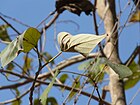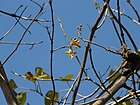Note: This is a project under development. The articles on this wiki are just being initiated and broadly incomplete. You can Help creating new pages.
Difference between revisions of "Gmelina arborea - Gambhari"
(→Photo Gallery) |
(-stub) |
||
| Line 1: | Line 1: | ||
| − | |||
| − | |||
[[File:Gmelina arborea leaves I IMG 3458.jpg|thumb|right|''Gmelina arborea'', ''Madhumati'']] | [[File:Gmelina arborea leaves I IMG 3458.jpg|thumb|right|''Gmelina arborea'', ''Madhumati'']] | ||
Revision as of 17:57, 11 May 2018
Madhumati locally known as gamhar. it is a fast-growing deciduous tree. Occurring naturally throughout greater part of India at altitudes up to 1,500 meters. It also occurs naturally in Myanmar, Thailand, Laos, Cambodia, Vietnam, and in southern provinces of China.
Contents
- 1 Uses
- 2 Parts Used
- 3 Chemical Composition
- 4 Common names
- 5 Properties
- 6 Habit
- 7 Identification
- 8 List of Ayurvedic medicine in which the herb is used
- 9 Where to get the saplings
- 10 Mode of Propagation
- 11 How to plant/cultivate
- 12 Commonly seen growing in areas
- 13 Photo Gallery
- 14 References
- 15 External Links
Uses
bilious fever, gonorrhoea, cough, wounds, ulcers, leprosy, blood diseases, Diarrhea.
Parts Used
Roots, stem, rootbark, stem bark, fruits.
Chemical Composition
hexenol (17.9%), 1-octen-3-ol (8.4%) and hexanol (6.1%) among the aliphatic alcohols; heptacosane (5.6%), pentacosane (3.8%) and 1-pentacosene (3.2%) among the hydrocarbons; and nonanal (8.7%) and (E)-2-decenal (3.0%)[1]
Common names
| Language | Common name |
|---|---|
| Kannada | Shivani |
| Hindi | Gamhar |
| Malayalam | Kumbil |
| Tamil | Kumalaamaram |
| Telugu | Peddagumudutekku |
| Marathi | NA |
| Gujarathi | NA |
| Punjabi | NA |
| Kashmiri | NA |
| Sanskrit | Madhumati |
| English | Gamhar |
Properties
Reference: Dravya - Substance, Rasa - Taste, Guna - Qualities, Veerya - Potency, Vipaka - Post-digesion effect, Karma - Pharmacological activity, Prabhava - Therepeutics.
Dravya
Rasa
Tikta (Bitter), Kashaya (Astringent), Madhura (Sweet)
Guna
Guru (heavy)
Veerya
Ushna (Hot)
Vipaka
Katu (Pungent)
Karma
Vata, Pitta
Prabhava
Habit
Identification
Leaf
| Kind | Shape | Feature |
|---|---|---|
| Simple | ovate | 4-8 inch long, acuminate, entire |
Flower
| Type | Size | Color and composition | Stamen | More information |
|---|---|---|---|---|
| Unisexual | 12 inch | brownish-yellow | 5-20 | Calyx campanulate, tomentose, 5-lobed and In small usually 3-flowered cymes arranged along the branches of a densely fulvous-tomentose panicle |
Fruit
| Type | Size | Mass | Appearance | Seeds | More information |
|---|---|---|---|---|---|
| ovoid | 1.5-2.0 cm long | sometimes with portion of attached pedicel, two seeded | With hooked hairs | {{{6}}} |
Other features
List of Ayurvedic medicine in which the herb is used
- Vishatinduka Taila as root juice extract
Where to get the saplings
Mode of Propagation
How to plant/cultivate
The plant can succeed in very dry to wet areas in the tropics and subtropics, where it is found at elevations up to 2,100 metres. It grows best in areas where annual daytime temperatures are within the range 22 - 34°c, but can tolerate 16 - 46°c[3]
Commonly seen growing in areas
tropical semi-evergreen, sub-montane, moist teak forests.
Photo Gallery
References
External Links
- Ayurvedic Herbs known to be helpful to treat bilious fever
- Ayurvedic Herbs known to be helpful to treat gonorrhoea
- Ayurvedic Herbs known to be helpful to treat cough
- Ayurvedic Herbs known to be helpful to treat wounds
- Ayurvedic Herbs known to be helpful to treat ulcers
- Ayurvedic Herbs known to be helpful to treat leprosy
- Ayurvedic Herbs known to be helpful to treat blood diseases
- Ayurvedic Herbs known to be helpful to treat Diarrhea
- Herbs with Roots used in medicine
- Herbs with stem used in medicine
- Herbs with rootbark used in medicine
- Herbs with stem bark used in medicine
- Herbs with fruits used in medicine
- Herbs with common name in Kannada
- Herbs with common name in Hindi
- Herbs with common name in Malayalam
- Herbs with common name in Tamil
- Herbs with common name in Telugu
- Herbs with common name in Sanskrit
- Herbs with common name in English
- Habit - Deciduous Tree
- Index of Plants which can be propagated by Seeds
- Index of Plants which can be propagated by Cuttings
- Herbs that are commonly seen in the region of tropical semi-evergreen
- Herbs that are commonly seen in the region of sub-montane
- Herbs that are commonly seen in the region of moist teak forests
- Herbs








